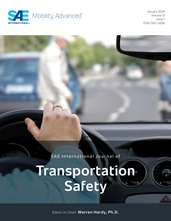NHTSA has been investigating a new test mode in which a research moving deformable barrier (RMDB) impacts a stationary vehicle at 90.1 kph, a 15 degree angle, and a 35% vehicle overlap. The test utilizes the THOR NT with modification kit (THOR) dummy positioned in both the driver and passenger seats. This paper compares the behavior of the THOR and Hybrid III dummies during this oblique research test mode.
A series of four full vehicle oblique impact crash tests were performed. Two tests were equipped with THOR dummies and two tests were equipped with Hybrid III dummies. All dummies represent 50th percentile males and were positioned in the vehicle according to the FMVSS208 procedure. The Hybrid III dummies were instrumented with the Nine Accelerometer Package (NAP) to calculate brain injury criteria (BrIC) as well as THOR-Lx lower legs. Injury responses were recorded for each dummy during the event. High speed cameras were used to capture vehicle and dummy kinematics. The vehicle restraint devices and their associated deployment times remained the same for each test. Post test analysis investigated each dummy injury response, kinematics, and vehicle structural performance. The results of the current study show that during an oblique impact, where significant lateral motion of the vehicle is observed, there are differences between the THOR and Hybrid III dummies.
